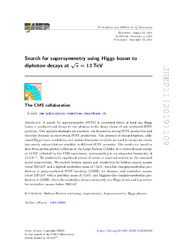Search for supersymmetry using Higgs boson to diphoton decays at s√ = 13 TeV
| dc.contributor.author | Sirunyan, A. M. | |
| dc.contributor.author | Işıldak, Bora | |
| dc.date.accessioned | 2020-06-19T13:37:48Z | |
| dc.date.available | 2020-06-19T13:37:48Z | |
| dc.date.issued | 2019-12-04 | |
| dc.identifier.issn | 1029-8479 | en_US |
| dc.identifier.uri | http://hdl.handle.net/10679/6628 | |
| dc.identifier.uri | https://link.springer.com/article/10.1007/JHEP11(2019)109 | |
| dc.description.abstract | A search for supersymmetry (SUSY) is presented where at least one Higgs boson is produced and decays to two photons in the decay chains of pair-produced SUSY particles. Two analysis strategies are pursued: one focused on strong SUSY production and the other focused on electroweak SUSY production. The presence of charged leptons, additional Higgs boson candidates, and various kinematic variables are used to categorize events into search regions that are sensitive to different SUSY scenarios. The results are based on data from proton-proton collisions at the Large Hadron Collider at a center-of-mass energy of 13 TeV collected by the CMS experiment, corresponding to an integrated luminosity of 77.5 fb−1. No statistically significant excess of events is observed relative to the standard model expectations. We exclude bottom squark pair production for bottom squark masses below 530 GeV and a lightest neutralino mass of 1 GeV; wino-like chargino-neutralino production in gauge-mediated SUSY breaking (GMSB) for chargino and neutralino masses below 235 GeV with a gravitino mass of 1 GeV; and higgsino-like chargino-neutralino production in GMSB, where the neutralino decays exclusively to a Higgs boson and a gravitino for neutralino masses below 290 GeV. | en_US |
| dc.description.sponsorship | BMBWF and FWF (Austria); FNRS and FWO (Belgium); CNPq, CAPES, FAPERJ, FAPERGS, and FAPESP (Brazil); MES (Bulgaria); CERN; CAS, MoST, and NSFC (China); COLCIENCIAS (Colombia); MSES and CSF (Croatia); RPF (Cyprus); SENESCYT (Ecuador); MoER, ERC IUT, PUT and ERDF (Estonia); Academy of Finland, MEC, and HIP (Finland); CEA and CNRS/IN2P3 (France); BMBF, DFG, and HGF (Germany); GSRT (Greece); NKFIA (Hungary); DAE and DST (India); IPM (Iran); SFI (Ireland); INFN (Italy); MSIP and NRF (Republic of Korea); MES (Latvia); LAS (Lithuania); MOE and UM (Malaysia); BUAP, CINVESTAV, CONACYT, LNS, SEP, and UASLP-FAI (Mexico); MOS (Montenegro); MBIE (New Zealand); PAEC (Pakistan); MSHE and NSC (Poland); FCT (Portugal); JINR (Dubna); MON, RosAtom, RAS, RFBR, and NRC KI (Russia); MESTD (Serbia); SEIDI, CPAN, PCTI, and FEDER (Spain); MOSTR (Sri Lanka); Swiss Funding Agencies (Switzerland); MST (Taipei); ThEPCenter, IPST, STAR, and NSTDA (Thailand); TUBITAK and TAEK (Turkey); NASU and SFFR (Ukraine); STFC (United Kingdom); DOE and NSF (USA). Individuals have received support from the Marie-Curie program and the European Research Council and Horizon 2020 Grant, contract Nos. 675440, 752730, and 765710 (European Union); the Leventis Foundation; the A.P. Sloan Foundation; the Alexander Von Humboldt Foundation; the Belgian Federal Science Policy Office; the Fonds pour la Formation h la Recherche dans l'Industrie et dans l'Agriculture (FRIA-Belgium); the Agentschap voor Innovatie door Wetenschap en Technologie (IWT-Belgium); the F.R.S.-FNRS and FWO (Belgium) under the "Excellence of Science - EOS" - be.h project n. 30820817; the Beijing Municipal Science & Technology Commission, No. Z181100004218003; the Ministry of Education, Youth and Sports (MEYS) of the Czech Republic; the Lendiilet ("Momentum") Program and the Jnos Bolyai Research Scholarship of the Hungarian Academy of Sciences, the New National Excellence Program tNKP, the NKFIA research grants 123842, 123959, 124845, 124850, 125105, 128713, 128786, and 129058 (Hungary); the Council of Science and Industrial Research, India; the HOMING PLUS program of the Foundation for Polish Science, cofinanced from European Union, Regional Development Fund, the Mobility Plus program of the Ministry of Science and Higher Education, the National Science Center (Poland), contracts Harmonia 2014/14/M/ST2/00428, Opus 2014/13/B/ST2/02543, 2014/15/B/ST2/03998, and 2015/19/B/ST2/02861, Sonatabis 2012/07/E/ST2/01406; the National Priorities Research Program by Qatar National Research Fund; the Ministry of Science and Education, grant no. 3.2989.2017 (Russia); the Programa Estatal de Fomento de la Investigacion Cientffica y Tecnica de Excelencia Marfa de Maeztu, grant MDM-2015-0509 and the Programa Severo Ochoa del Principado de Asturias; the Thalis and Aristeia programs cofinanced by EU-ESF and the Greek NSRF; the Rachadapisek Sompot Fund for Postdoctoral Fellowship, Chulalongkorn University and the Chulalongkorn Academic into Its 2nd Century Project Advancement Project (Thailand); the Welch Foundation, contract C-1845; and the Weston Havens Foundation (USA). | |
| dc.language.iso | eng | en_US |
| dc.publisher | Springer Nature | en_US |
| dc.relation.ispartof | Journal of High Energy Physics | |
| dc.rights | openAccess | |
| dc.title | Search for supersymmetry using Higgs boson to diphoton decays at s√ = 13 TeV | en_US |
| dc.type | Article | en_US |
| dc.description.version | Publisher version | en_US |
| dc.peerreviewed | yes | en_US |
| dc.publicationstatus | Published | en_US |
| dc.contributor.department | Özyeğin University | |
| dc.contributor.authorID | (ORCID 0000-0002-0283-5234 & YÖK ID 124605) Işıldak, Bora | |
| dc.contributor.ozuauthor | Işıldak, Bora | |
| dc.creator | The CMS Collaboration | |
| dc.identifier.volume | 109 | en_US |
| dc.identifier.issue | 11 | en_US |
| dc.identifier.wos | WOS:000514879600001 | |
| dc.identifier.doi | 10.1007/JHEP11(2019)109 | en_US |
| dc.subject.keywords | Hadron-Hadron scattering (experiments) | en_US |
| dc.subject.keywords | Supersymmetry | en_US |
| dc.subject.keywords | Higgs physics | en_US |
| dc.identifier.scopus | SCOPUS:2-s2.0-85076395979 | |
| dc.contributor.authorMale | 1 | |
| dc.relation.publicationcategory | Article - International Refereed Journal - Institution Academic Staff |
Files in this item
This item appears in the following Collection(s)
Share this page



